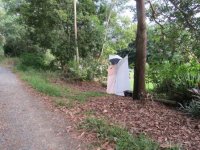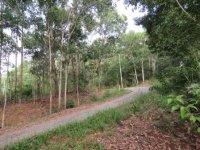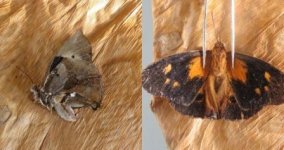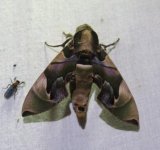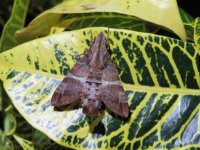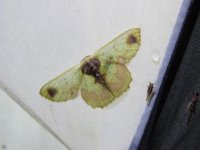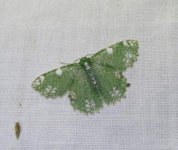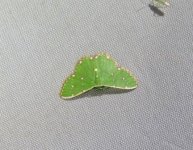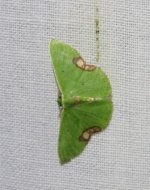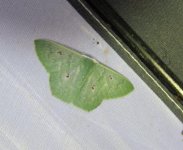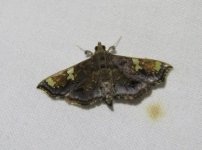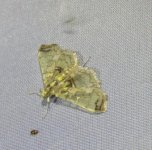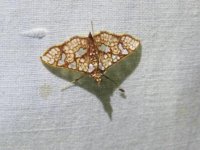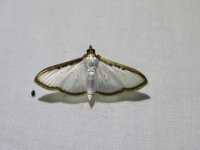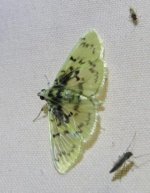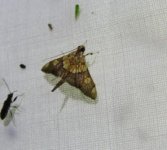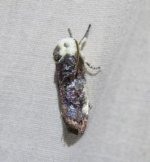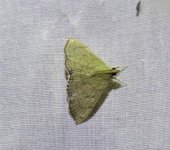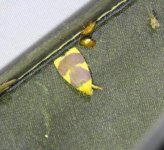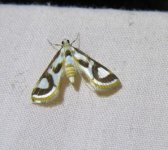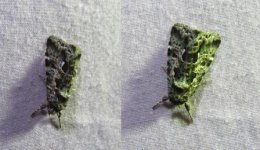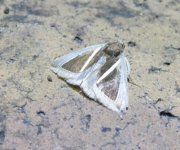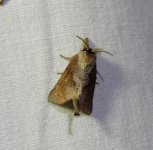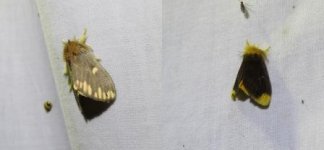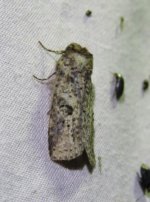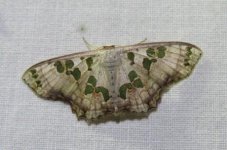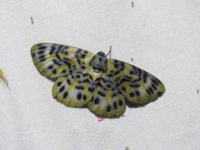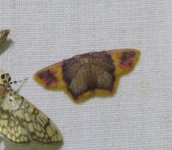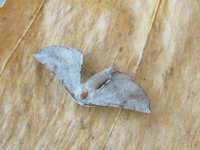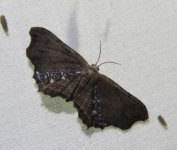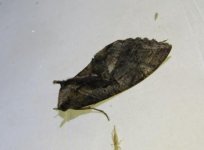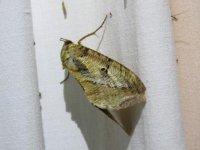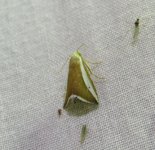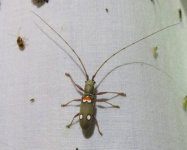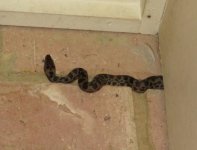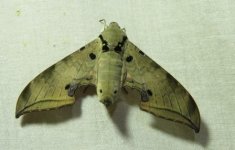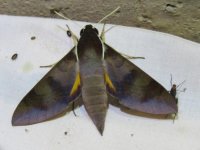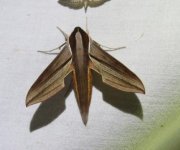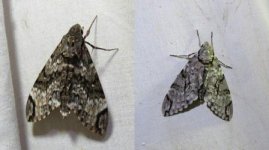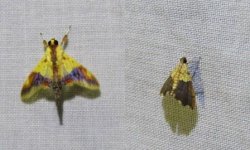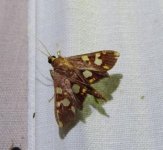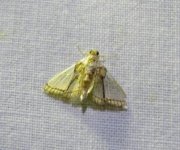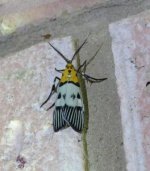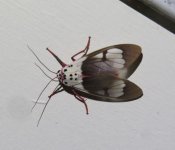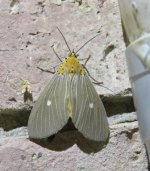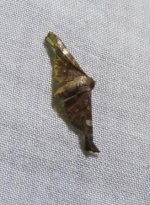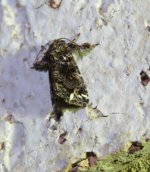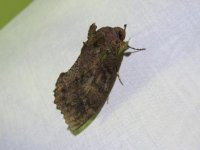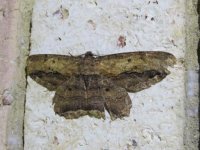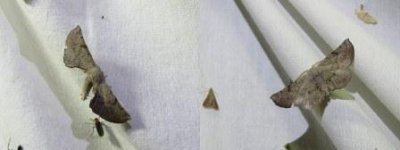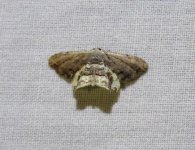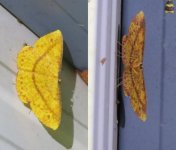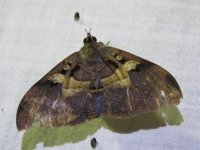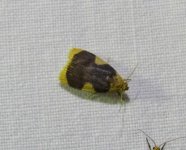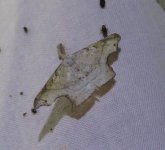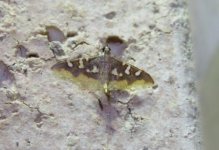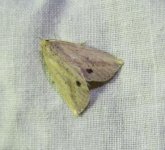Another thread with two months combined and no certainty of many postings....not because there are no moths because there are plenty but unfortunately my Telco "forgot" to process our order and so we are without phone and internet until July other than via my dongle which is not the cheapest way to get internet. I am hoping to find a local cafe with free Wifi and good coffee then I can update......
-
Welcome to BirdForum, the internet's largest birding community with thousands of members from all over the world. The forums are dedicated to wild birds, birding, binoculars and equipment and all that goes with it.
Please register for an account to take part in the discussions in the forum, post your pictures in the gallery and more.
You are using an out of date browser. It may not display this or other websites correctly.
You should upgrade or use an alternative browser.
You should upgrade or use an alternative browser.
Mossman Moths (Aus) - June and July 2016 (1 Viewer)
- Thread starter Dom F
- Start date
More options
Who Replied?I have been able to Log On at my local library so will have some access on a daily basis during the week as will try and connect before I collect the children from school.
Well if the first week is anything to go by my new house could be exceedingly productive when the season proper starts in the Wet. Most of the garden is manicured with the occasional native species but at its closest point the edge of Daintree National Park is no further than 50 feet from our boundary. There is no obvious trap location that I can get power to without the light shining on what is a surprisingly busy road that runs along side the property so I have moved the trap around in an attempt to find the best location – I am still trying!
Photos One and Two show my current tap location and the “view” from the bulb
Moth Butterfly (Liphyra brassolis) – literally the first species that appeared at the trap on my first nights trapping and this is the second individual I have caught of this scarce / rarely encountered species in four months – according to several of my contacts this is exceptional! This is another male.
Daphnis protudens (Sphingidae) – I was hoping that this large species would appear in the garden at some stage but I was certainly not expecting to catch it in the first week.
Macroglossum hirundo (Sphingidae) – had no caught a fresh hirundo for several weeks in Yorkeys so was quite surprised to catch this.
Well if the first week is anything to go by my new house could be exceedingly productive when the season proper starts in the Wet. Most of the garden is manicured with the occasional native species but at its closest point the edge of Daintree National Park is no further than 50 feet from our boundary. There is no obvious trap location that I can get power to without the light shining on what is a surprisingly busy road that runs along side the property so I have moved the trap around in an attempt to find the best location – I am still trying!
Photos One and Two show my current tap location and the “view” from the bulb
Moth Butterfly (Liphyra brassolis) – literally the first species that appeared at the trap on my first nights trapping and this is the second individual I have caught of this scarce / rarely encountered species in four months – according to several of my contacts this is exceptional! This is another male.
Daphnis protudens (Sphingidae) – I was hoping that this large species would appear in the garden at some stage but I was certainly not expecting to catch it in the first week.
Macroglossum hirundo (Sphingidae) – had no caught a fresh hirundo for several weeks in Yorkeys so was quite surprised to catch this.
Attachments
GEOMETRINAE
The Geometrinae fauna in Yorkeys was very impressive and if early indicators re anything to go by it is going to be equally impressive here – I have caught five new species already and have a couple of Agathia species that I need to check when I have a more reliable internet connection!
Agathiopsis basipuncta – have only caught this on one occasion so far
Anisozyga fascinans – male
Comibaena incutaria – a single individual caught but a similar looking moth vanished the first night before I could get a photo
Comibaena mariae – this seems to be the common species here with several individuals appearing nightly
Prasinocyma caniola – single caught last night
The Geometrinae fauna in Yorkeys was very impressive and if early indicators re anything to go by it is going to be equally impressive here – I have caught five new species already and have a couple of Agathia species that I need to check when I have a more reliable internet connection!
Agathiopsis basipuncta – have only caught this on one occasion so far
Anisozyga fascinans – male
Comibaena incutaria – a single individual caught but a similar looking moth vanished the first night before I could get a photo
Comibaena mariae – this seems to be the common species here with several individuals appearing nightly
Prasinocyma caniola – single caught last night
Attachments
SPILOMELINAE
Crambidae diversity seems to be high here as well. At the moment due to lack of access to my main references there are many species of Accentropinae that I am waiting to identify but here are five Spilomelinae that were new to me this week
Chryaothyridiae invertalis – male; have caught small numbers of this species twice this week this species twice this week
Didymostoma aurotinctalis – have caught this stunning moth on several occasions this week. The photos do not do the colours any justice
Glyphodes canthusalis – this genus contains some of my favourite species of Spilomelinae. This seems to be a common species here with up to ten individuals being caught some nights
Sisyrophora pfeirrerae – when I first saw this I initially thought it was a Palpita spp. Have only seen this once so far.
Syllepte polydonta – seen most nights in small numbers.
Crambidae diversity seems to be high here as well. At the moment due to lack of access to my main references there are many species of Accentropinae that I am waiting to identify but here are five Spilomelinae that were new to me this week
Chryaothyridiae invertalis – male; have caught small numbers of this species twice this week this species twice this week
Didymostoma aurotinctalis – have caught this stunning moth on several occasions this week. The photos do not do the colours any justice
Glyphodes canthusalis – this genus contains some of my favourite species of Spilomelinae. This seems to be a common species here with up to ten individuals being caught some nights
Sisyrophora pfeirrerae – when I first saw this I initially thought it was a Palpita spp. Have only seen this once so far.
Syllepte polydonta – seen most nights in small numbers.
Attachments
Argrotera namorokalis (Spilomelinae) – a new species for me, only seen once so far
Cryptophasa poryphyritis (Xylorctidae) – male; when I first saw this I did wonder if it was a small Cossidae but closer examination of its palps showed that it was not!
Hyalobathra crenulata (Spilomelinae) – this species was scarce in Yorkeys but here I have caught it on four nights so far
Imma cf chrysoplaca (Immidae) – another potential new species for Australia, have seen this twice this week but not managed to retain a specimen yet. The ID is based on the Papuan Insect Foundation webpage, it is not an exact match but I am not sure how varied this species is.
Theila siennata (Accentropinae) – with a reasonably sized pond in the garden unsurprisingly Accentropinae are quite a feature at the trap but as I do not have a reliable internet connection they are going to have to wait a few weeks for identification. This species is one of the more obvious ones and is present in good numbers every night
Cryptophasa poryphyritis (Xylorctidae) – male; when I first saw this I did wonder if it was a small Cossidae but closer examination of its palps showed that it was not!
Hyalobathra crenulata (Spilomelinae) – this species was scarce in Yorkeys but here I have caught it on four nights so far
Imma cf chrysoplaca (Immidae) – another potential new species for Australia, have seen this twice this week but not managed to retain a specimen yet. The ID is based on the Papuan Insect Foundation webpage, it is not an exact match but I am not sure how varied this species is.
Theila siennata (Accentropinae) – with a reasonably sized pond in the garden unsurprisingly Accentropinae are quite a feature at the trap but as I do not have a reliable internet connection they are going to have to wait a few weeks for identification. This species is one of the more obvious ones and is present in good numbers every night
Attachments
Cascera bella (Notodontinae) – a new species to me and seemingly a common one here with small numbers being caught daily
Chalciope alcyone (Catocalinae) – have only seen this species a couple of times in Yorkeys, have caught it every couple of days here so far
Clostera rubida (Pygaerinae) – by far the freshest individual of this species that I have seen
Euproctis actor (left) and subnobilis (right) (Lymantriinae) – Eu. actor is a new species for me, I have only caught it once so far; Eu.subnobilis was an occasional visitor to the garden in Yorkeys where as here I have caught it nightly so far
Gargettiana punctissima (Notodontinae) – prior to moving here I had only seen two individuals of this species, in this garden it seems to be a regular visitor with a peak of three on one night
Chalciope alcyone (Catocalinae) – have only seen this species a couple of times in Yorkeys, have caught it every couple of days here so far
Clostera rubida (Pygaerinae) – by far the freshest individual of this species that I have seen
Euproctis actor (left) and subnobilis (right) (Lymantriinae) – Eu. actor is a new species for me, I have only caught it once so far; Eu.subnobilis was an occasional visitor to the garden in Yorkeys where as here I have caught it nightly so far
Gargettiana punctissima (Notodontinae) – prior to moving here I had only seen two individuals of this species, in this garden it seems to be a regular visitor with a peak of three on one night
Attachments
Antitrygodes parvimacula (Sterrhinae) – have only seen one of this stunning looking moth, this genus is quite common in New Guinea and Malaysia apparently but this seems to be the only representative in Australia
Bracca rotundata (Ennominae) – I used to catch this amazing looking moth occasionally in Yorkeys, here it appears to be far more frequent, I have caught it nightly with a peak of three on the sheet together
Chrysocraspeda cruoria (Sterrhinae) – have seen several Chrysocraspeda individuals this week but this is the only one that I have narrowed down to a probably species as I need to access better resources for the others!
Circopetes obtuse (Oenochrominae) – a new species for me last night
Epiplema coeruleotincta (Epipleminae) – only caught this on one night so far when there were three on the sheet.
Bracca rotundata (Ennominae) – I used to catch this amazing looking moth occasionally in Yorkeys, here it appears to be far more frequent, I have caught it nightly with a peak of three on the sheet together
Chrysocraspeda cruoria (Sterrhinae) – have seen several Chrysocraspeda individuals this week but this is the only one that I have narrowed down to a probably species as I need to access better resources for the others!
Circopetes obtuse (Oenochrominae) – a new species for me last night
Epiplema coeruleotincta (Epipleminae) – only caught this on one night so far when there were three on the sheet.
Attachments
Eudocima fullonia (Calpinae) – a single caught on the first night
Eudocima materna (Calpinae) – a single caught a couple of nights ago
Rivula niphodesma (Rivulinae) - a new species for me; unfortunately the photos are not as crisp as I would like as photographing on a sheet that is gently swaying is an art I have not mastered yet!
Olenecamptus bilobus – a very attractive Longhorn Beetle that appears in good numbers some nights
Spotted Python – this little beauty is living behind the fascia of the roof just above our front door. For the first few nights I was seeing it every time I went and checked the trap but following what was a very cold night for the Tropics on Sunday/Monday I have not seen it since. This individual is very young with a body barely thicker than my thumb so it will hopefully keep all the gecko’s in check – have not mentioned it to my wife who having had a couple of very close encounters with Black Mamba when she lived in South Africa has a very healthy dislike of snakes!
Eudocima materna (Calpinae) – a single caught a couple of nights ago
Rivula niphodesma (Rivulinae) - a new species for me; unfortunately the photos are not as crisp as I would like as photographing on a sheet that is gently swaying is an art I have not mastered yet!
Olenecamptus bilobus – a very attractive Longhorn Beetle that appears in good numbers some nights
Spotted Python – this little beauty is living behind the fascia of the roof just above our front door. For the first few nights I was seeing it every time I went and checked the trap but following what was a very cold night for the Tropics on Sunday/Monday I have not seen it since. This individual is very young with a body barely thicker than my thumb so it will hopefully keep all the gecko’s in check – have not mentioned it to my wife who having had a couple of very close encounters with Black Mamba when she lived in South Africa has a very healthy dislike of snakes!
Attachments
Hopefully back properly now - my internet kept dropping out but we are back on older tried and tested technology, rather than a satellite dish my service is coming down the phone line again so am hopeful that whilst it is not as fast it will be reliable. Well what an opening month in my new house June turned into - with roughly 2200 photos still to work through the tally for June is 252 spp my equal best monthly tally ever (also got 252 in April 2015) - I should point out that June / July is mid winter in the southern hemisphere and the Dry season here so this bodes very well for the main season from October to April depending on the Wet!
I am going to go through my data base and try and pick out a few of the highlights but there are so many that it will only be a few. I will then try and get up to date for July.
I am going to go through my data base and try and pick out a few of the highlights but there are so many that it will only be a few. I will then try and get up to date for July.
Sphingids have been very well represented in June with 15 species occurring, many looking incredibly fresh and having clearly only recently emerged:
Ambulyx dohertyi - in Yorkeys this was an infrequent visitor with I think no more than four individuals recorded. So far in my new garden I have caught ten all of which have been males.
Gnathothlibus eras - a couple of very fresh individuals have emerged both of which have been males and so can be separated from Gnathothlibus australiensis without the need for dissection
Hippotion boerhaviae - with out doubt the nicest individual of this species that I have caught
Psilogramma menephron (L) and Psilogramma papuensis (R) - another genus that is occurring in numbers. In Yorkeys I caught three or four a year if I was lucky, here I have caught three in a night. All my Psilogramma are being retained and sent to Max Moulds who is writing the definitive guide to Australian Sphingids and needed fresh samples of this genus
Ambulyx dohertyi - in Yorkeys this was an infrequent visitor with I think no more than four individuals recorded. So far in my new garden I have caught ten all of which have been males.
Gnathothlibus eras - a couple of very fresh individuals have emerged both of which have been males and so can be separated from Gnathothlibus australiensis without the need for dissection
Hippotion boerhaviae - with out doubt the nicest individual of this species that I have caught
Psilogramma menephron (L) and Psilogramma papuensis (R) - another genus that is occurring in numbers. In Yorkeys I caught three or four a year if I was lucky, here I have caught three in a night. All my Psilogramma are being retained and sent to Max Moulds who is writing the definitive guide to Australian Sphingids and needed fresh samples of this genus
Attachments
Crambidae. Spilomelinae is another family that is turning up in good numbers considering the time of year.
Agrotera pictalis (L) and basinotata (R) - two species that were new to me this month and have now turned up on several dates
Chalcidoptera emissalis - this male turned up on one date, another new species for me
Leucinodes ANIC1 - a known "unknown" recorded on one date in June
Pyralidae; Pyralinae a much more infrequently encountered family
Vitessa plumosa AH01 - the genus Vitessa is one that I have been hoping to catch for months and finally one appeared mid June. They are a genus of large (wing span at least 3cm) and variable moths. This is close to plumosa and matches a specimen on BOLD labelled as AH01, and is presumably being looked at to determine whether it actually is a seperate species or just a variation within plumosa
Agrotera pictalis (L) and basinotata (R) - two species that were new to me this month and have now turned up on several dates
Chalcidoptera emissalis - this male turned up on one date, another new species for me
Leucinodes ANIC1 - a known "unknown" recorded on one date in June
Pyralidae; Pyralinae a much more infrequently encountered family
Vitessa plumosa AH01 - the genus Vitessa is one that I have been hoping to catch for months and finally one appeared mid June. They are a genus of large (wing span at least 3cm) and variable moths. This is close to plumosa and matches a specimen on BOLD labelled as AH01, and is presumably being looked at to determine whether it actually is a seperate species or just a variation within plumosa
Attachments
Amerila nigropunctata (Erebidae; Arctiinae)- a new species for me this month
Asota caricae (Erebidae; Aganainae) - another new species for me this month
Calindoea dorilusalis (Thyrididae; Siculodinae) - I think that my ID is correct but its resting posture does not help! A new species for me
Callopistria rivularis (Noctuidae; Eriopinae) - another new species this month
Eudocima jordani (Erebidae; Calpinae) - only the second individual of this species that i have seen, the last was in April 2015
Asota caricae (Erebidae; Aganainae) - another new species for me this month
Calindoea dorilusalis (Thyrididae; Siculodinae) - I think that my ID is correct but its resting posture does not help! A new species for me
Callopistria rivularis (Noctuidae; Eriopinae) - another new species this month
Eudocima jordani (Erebidae; Calpinae) - only the second individual of this species that i have seen, the last was in April 2015
Attachments
Chorodna strixaria (Geometridae; Ennominae) - a large species with a wing span of 10cm+, another new species for me.
Circopetes obtusa (Geometridae; Oenochrominae) - I see this moth occasionally but this is the first time I have seen its hindwings
Epiplema thiocosma (Uraniidae; Epipleminae) - a distinctively marked member of this genus and another new species for me
Eumelea duponchelii (Geometridae; Desmobathrinae) - one of several similar and variable species, I am checking my ID but think that this is correct
Ischyja neocherina (Erebidae; Catocalinae) - this large moth with a wing span of c8cm+ is endemic to North Queensland. I have recorded it twice this year and both individuals have been females
Circopetes obtusa (Geometridae; Oenochrominae) - I see this moth occasionally but this is the first time I have seen its hindwings
Epiplema thiocosma (Uraniidae; Epipleminae) - a distinctively marked member of this genus and another new species for me
Eumelea duponchelii (Geometridae; Desmobathrinae) - one of several similar and variable species, I am checking my ID but think that this is correct
Ischyja neocherina (Erebidae; Catocalinae) - this large moth with a wing span of c8cm+ is endemic to North Queensland. I have recorded it twice this year and both individuals have been females
Attachments
Imma chrysoploca (Immidae) - I have now caught a further two individuals of this species and they are currently at ANIC where their identity has been confirmed as chrysoploca. There were apparently a couple of un-identified Imma in the collection that match mine all collected from FNQ
Ozola hollowayi (Geometridae; Desmobathrinae) - this has been identified for me by staff at ANIC and is apparently an uncommon species, I have caught five so far in the garden and specimens have been sent down to be added to the ANIC
Prophantis sp (Crambidae; Spilomelinae) - specimens of this are currently with ANIC as this does not match any images of Prophantis species on BOLD, none of the Australian species (including those currently not formally described) have the silver markings on the hindwing that this shows. Have caught this on three occasions so far
Synolulis punctitorna (Erebidae; Calpinae) - this matches photos of male punctitorna on the Papuan Insect Foundation webpage. This species range is currently only known from New Guinea, unfortunately have not been able to retain any specimens as yet to get the identification confirmed
Ozola hollowayi (Geometridae; Desmobathrinae) - this has been identified for me by staff at ANIC and is apparently an uncommon species, I have caught five so far in the garden and specimens have been sent down to be added to the ANIC
Prophantis sp (Crambidae; Spilomelinae) - specimens of this are currently with ANIC as this does not match any images of Prophantis species on BOLD, none of the Australian species (including those currently not formally described) have the silver markings on the hindwing that this shows. Have caught this on three occasions so far
Synolulis punctitorna (Erebidae; Calpinae) - this matches photos of male punctitorna on the Papuan Insect Foundation webpage. This species range is currently only known from New Guinea, unfortunately have not been able to retain any specimens as yet to get the identification confirmed
Attachments
Users who are viewing this thread
Total: 2 (members: 0, guests: 2)




